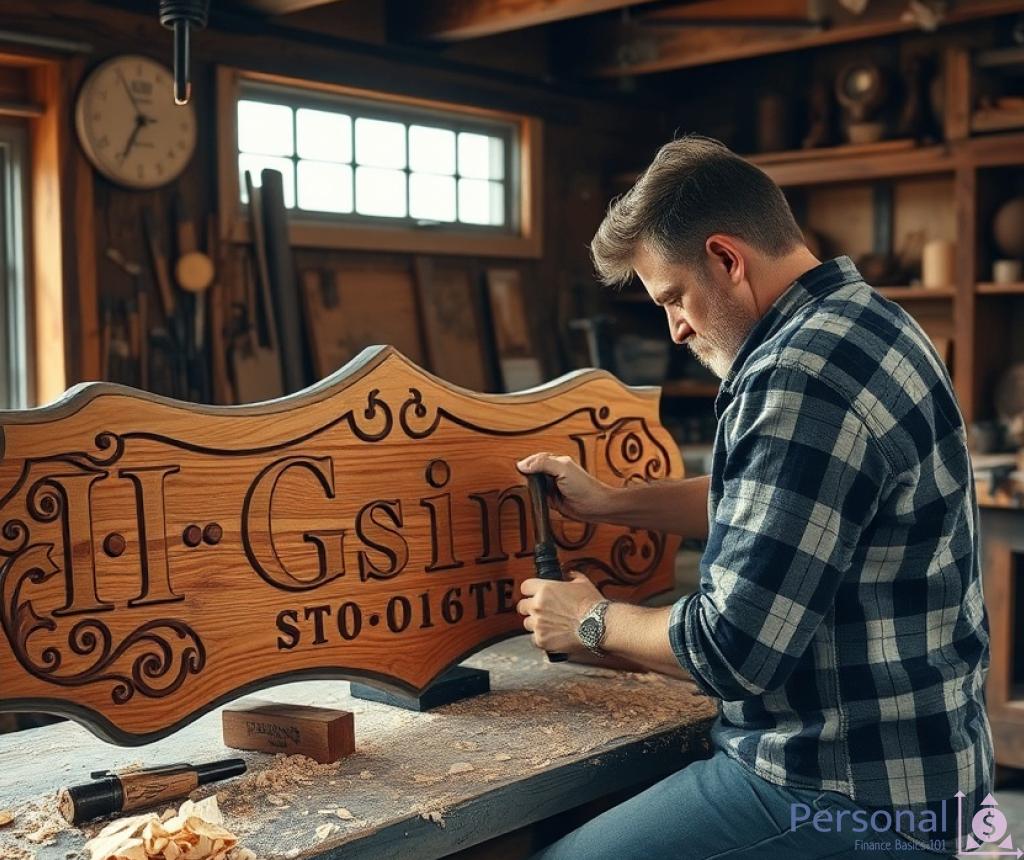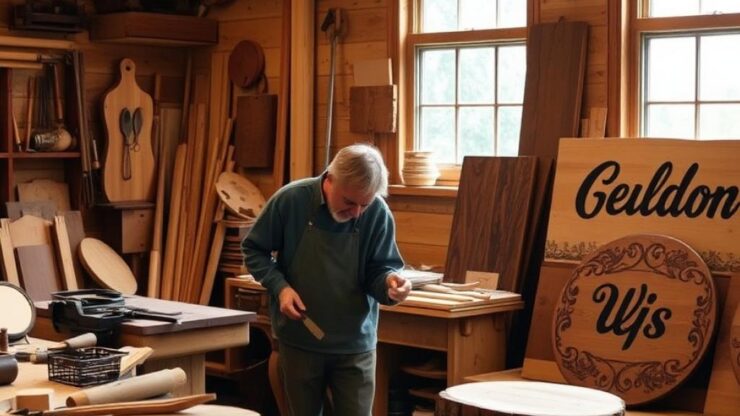Understanding the Craft of Custom Wood Sign Making

In today’s market, where personalization is key, custom wood sign making stands out not just as a craft but as an art form. This artisanal endeavor allows creators to express their individuality while offering unique products to consumers. Whether for homes, businesses, or events, custom signs have become a sought-after item that adds a personal touch.
Creating custom wood signs involves a blend of craftsmanship and creativity. The process typically begins with selecting the right type of wood, which can significantly influence both the aesthetics and durability of the sign. Popular choices include pine, cedar, and oak, each offering distinct characteristics. After selecting the wood, the following steps are generally undertaken:
- Designing: This involves sketching out the layout, considering font styles, and determining the overall look.
- Cutting: Using tools such as saws and routers, artisans cut the wood to shape and create any necessary grooves.
- Finishing: Sanding, staining, or painting are essential to give the sign a polished appearance.
- Sealing: A protective sealant is often applied to ensure longevity, especially for outdoor signs.
These steps highlight the meticulous nature of sign making, showcasing the skill required to transform raw wood into a beautiful piece of art.
The growing demand for personalized products has significantly influenced the custom wood sign industry. As consumers increasingly seek unique home decor and branding options, the market presents numerous opportunities for aspiring artisans. Here’s a quick comparison of potential avenues for custom wood sign makers:
| Market Segment | Potential Customers | Profit Margin |
|---|---|---|
| Home Decor | Homeowners, Interior Designers | Moderate to High |
| Business Signage | Small Businesses, Restaurants | High |
| Event Signage | Wedding Planners, Event Coordinators | Moderate |
By understanding these segments, wood sign makers can tailor their products to meet specific market needs, increasing their chances for success in this artisanal venture.
Essential Tools and Techniques for Wood Sign Creation
Creating stunning custom wood signs is not merely a matter of creativity; it necessitates a well-equipped workshop. The right tools are paramount to ensuring precision and efficiency during the sign-making process. Essential tools such as table saws, jigsaws, and router tools are indispensable for shaping wood and achieving intricate designs. Additionally, sandpaper and orbital sanders are crucial for smoothing surfaces, while wood chisels allow for detailed carving. Having the proper measuring tools, like rulers and squares, ensures that every cut and design is accurate, leading to a polished final product.
The art of wood sign creation transcends mere assembly; it encompasses a series of techniques that elevate a simple piece of wood into a striking work of art. The journey often begins with designing, where artisans can utilize software to visualize their creations or hand-draw layouts. Following this, the cutting phase demands not just precision but also creativity, as artisans often employ techniques such as scroll sawing for intricate designs or router engraving for depth. After shaping, finishing techniques such as staining or painting breathe life into the sign, allowing for personal expression and aesthetic appeal. Finally, the application of a protective sealant not only preserves the artwork but also enhances its visual charm, making it suitable for various environments.
By understanding these essential tools and techniques, aspiring wood sign makers can embark on their artisanal journey. The combination of the right equipment and skilled craftsmanship not only sets the foundation for high-quality signs but also opens the door to endless creative possibilities, making custom wood sign making a rewarding side business.
Marketing Your Custom Wood Signs: Strategies for Success
In the world of custom wood sign making, the artistry of crafting unique pieces must be complemented by effective marketing strategies. While the craftsmanship is crucial, how you present and promote your signs can significantly influence your success. It’s essential to adopt a multifaceted approach that not only showcases the beauty of your work but also connects with potential customers in meaningful ways.
Today, the digital landscape offers an array of platforms to reach your audience, making it imperative for wood sign makers to establish a strong online presence. Social media platforms such as Instagram and Pinterest are particularly effective for visual storytelling, allowing artisans to display their work and engage with followers. By sharing high-quality images of your signs, along with behind-the-scenes glimpses of the crafting process, you can create a compelling narrative that draws potential customers in. Utilizing hashtags strategically will enhance discoverability, ensuring your creations reach a broader audience.
While online marketing is vital, don’t underestimate the power of local connections. Participating in community events, craft fairs, and farmers’ markets can provide invaluable exposure to local customers who appreciate handcrafted goods. Collaborating with local businesses, such as interior designers or gift shops, can also open new avenues for sales. By creating partnerships that align with your brand values, you not only increase your visibility but also foster a sense of community around your business.
Moreover, consider offering customizable options for your signs that cater to specific local events or businesses. This personalization can create a buzz, encouraging word-of-mouth referrals. Engaging directly with your audience through workshops or demos can further establish your expertise and passion for the craft, making your brand more relatable and trustworthy.
Pricing Your Wood Sign Projects: A Guide for Artisans
When embarking on the journey of custom wood sign making, one of the most challenging yet critical aspects is determining how to price your creations. It’s not merely about covering costs; it’s about recognizing the value of the artisanal craftsmanship involved. Every sign is a testament to your skill, creativity, and dedication, and setting the right price can reflect this. A well-thought-out pricing strategy can differentiate your work in a competitive market while ensuring profitability.
Several key factors play a pivotal role in shaping your pricing structure. First and foremost, consider the materials you use; the type of wood, finishes, and any additional embellishments can significantly influence costs. High-quality materials not only enhance the aesthetic appeal but also increase durability, which can justify a higher price point. Next, evaluate the time invested in crafting each sign. From design to finishing touches, the hours spent should be factored into your pricing. Additionally, take into account your overhead costs, which may include tool maintenance, workspace rent, and marketing expenses. By comprehensively analyzing these variables, you can develop a pricing model that accurately reflects both your costs and the value of your craftsmanship.
To stand out in the crowded market of custom wood signs, it is crucial to define your unique selling proposition (USP). This is what sets your work apart and can justify a premium price. Perhaps your designs are particularly intricate or your materials are sourced sustainably. Emphasizing these aspects in your marketing can attract discerning customers willing to pay more for exceptional quality. Additionally, consider offering tiered pricing for different levels of customization. This approach allows potential buyers to select options that fit their budgets while appreciating the craftsmanship involved. Ultimately, pricing your wood signs is not just about numbers; it’s about telling the story of your craft and inviting customers to invest in a piece of art that resonates with them.
Exploring Design Trends in Custom Wood Signage
As the demand for personalized decor continues to surge, custom wood signage has emerged as a vibrant canvas for creativity. Artisans and designers are increasingly experimenting with innovative designs that not only convey messages but also enhance aesthetic appeal. This exploration of design trends in custom wood signage highlights the unique possibilities available to craftsmen and opens avenues for captivating creations that resonate with consumers.
In recent years, the push towards modern aesthetics has led to a notable shift towards minimalist designs in custom wood signage. This trend emphasizes simplicity and functionality, where clean lines and understated elegance take center stage. Artisans are opting for sleek fonts and muted color palettes, allowing the natural beauty of the wood to shine through. This approach not only caters to contemporary tastes but also creates a versatile product that can seamlessly blend into various environments, from cozy homes to chic offices. As consumers increasingly lean towards clutter-free spaces, the minimalist trend in wood signage stands out as a compelling choice.
While minimalism captures the essence of modern design, the juxtaposition of rustic charm with contemporary style is another trend gaining momentum. The use of reclaimed wood, distressed finishes, and vintage-inspired typography evokes a sense of nostalgia while appealing to the modern consumer’s desire for authenticity. This fusion creates unique pieces that tell a story, making them perfect for homes and businesses that wish to convey warmth and character. By incorporating elements such as natural wood grains and earthy tones, artisans can design signs that not only serve a functional purpose but also act as striking decor pieces, enhancing the overall ambiance of a space.
Furthermore, personalized touches in these rustic designs, such as custom engravings or hand-painted details, allow artisans to create truly one-of-a-kind signs. This trend not only highlights the craftsmanship involved but also fosters a deeper connection between the consumer and the product, enhancing the overall value of the piece.
In summary, the dynamic realm of custom wood signage is continuously evolving, with design trends reflecting broader consumer preferences for personalization, simplicity, and authenticity. As artisans embrace these trends, they not only expand their creative horizons but also position themselves to meet the diverse needs of an ever-changing market. By understanding and incorporating these design trends, wood sign makers can elevate their craft and thrive in their artisanal side business.
Disclaimer
This article has been created or edited with the support of artificial intelligence and is for informational purposes only. The information provided should not be considered investment advice. Please seek the support of a professional advisor before making any investment decisions.






